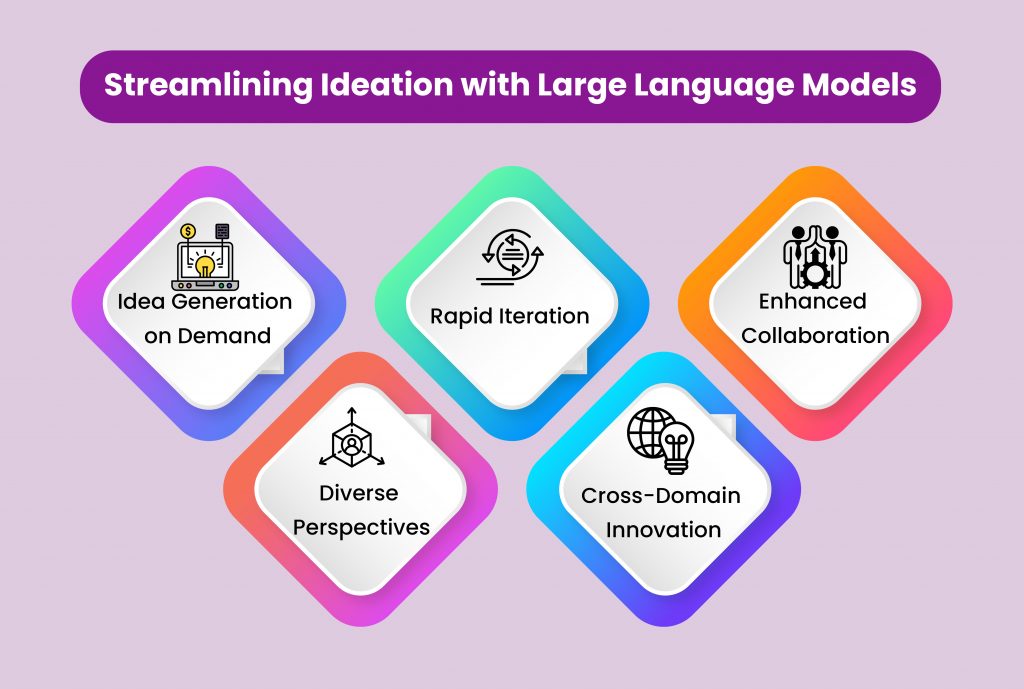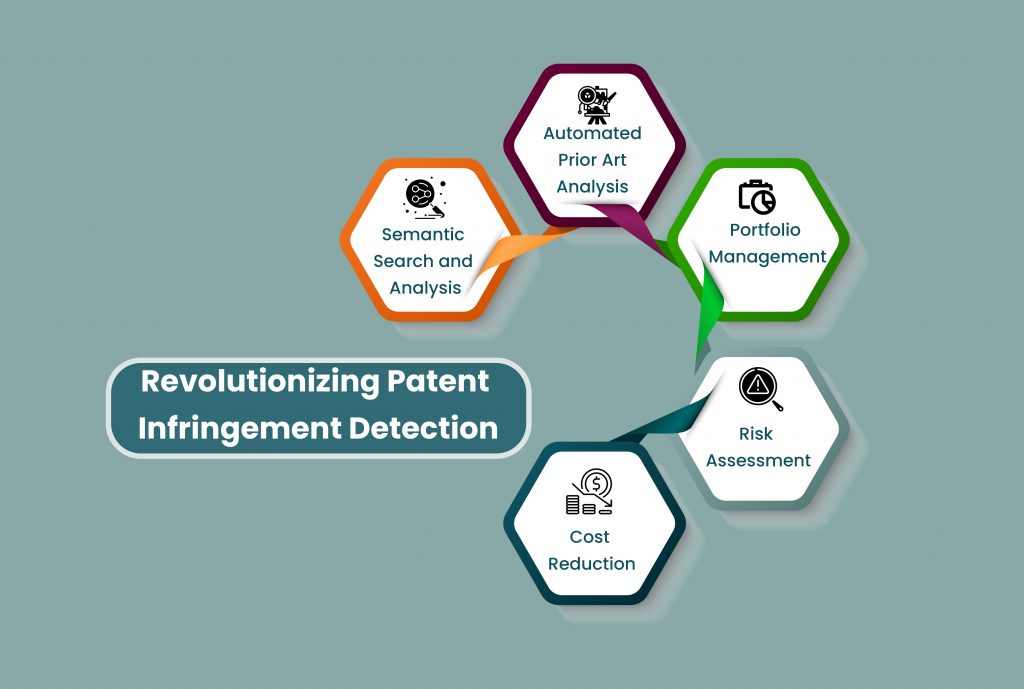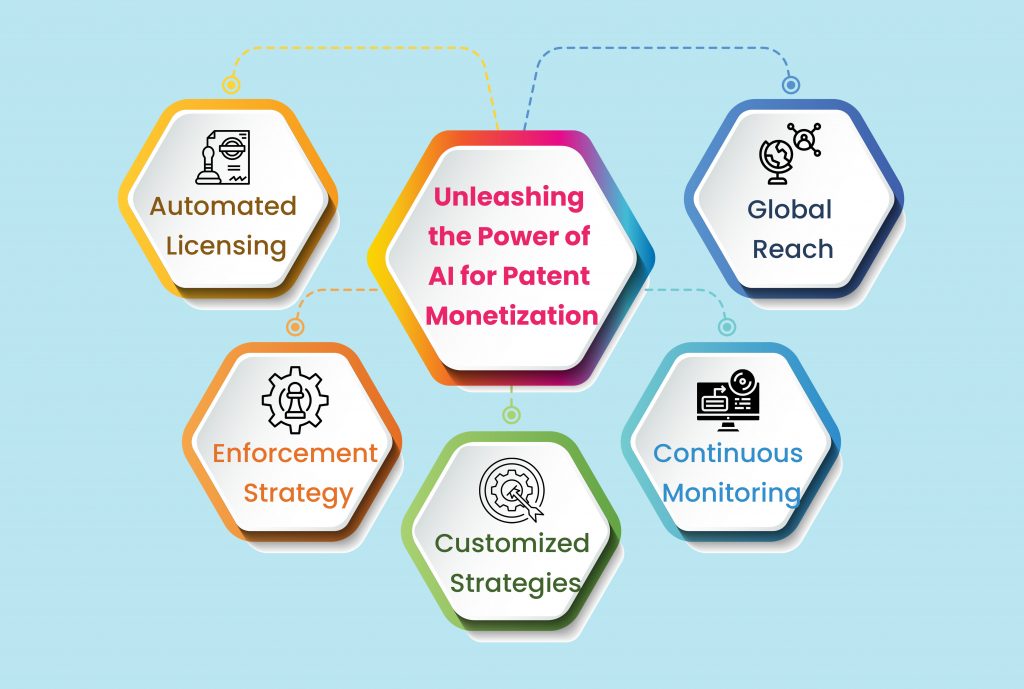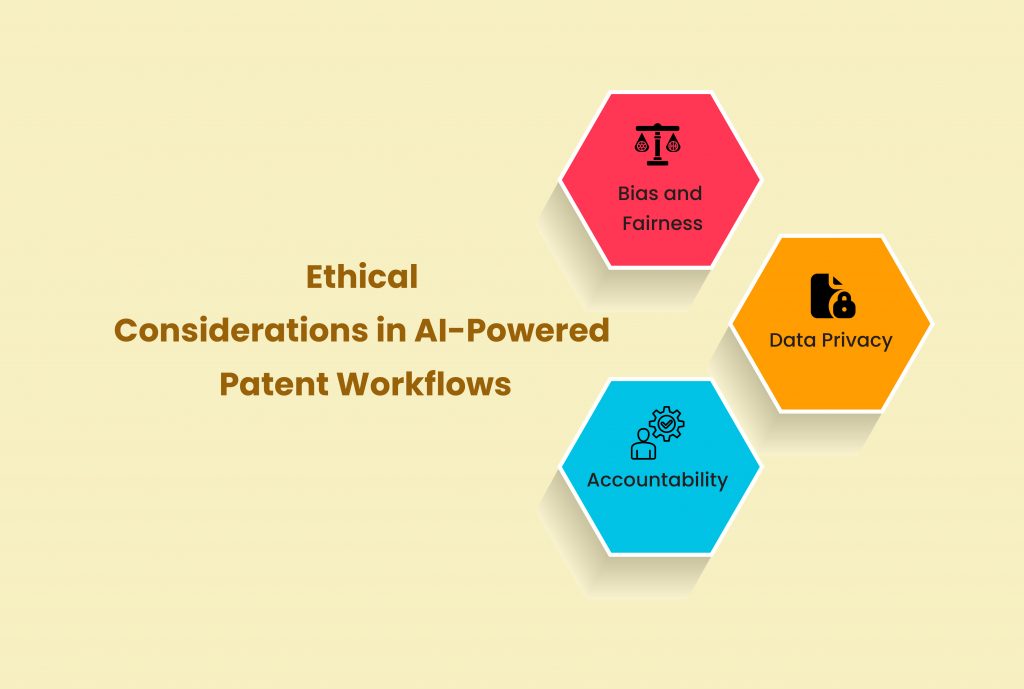
In the fast-paced world of intellectual property, where innovation reigns supreme, the role of large language models (LLMs) and Generative AI has quietly but profoundly transformed the landscape of patent workflows. These unsung heroes, often operating behind the scenes, have ushered in a new era of efficiency, creativity, and precision in patent-related tasks.
Welcome to a world where ideas are nurtured, patent applications are meticulously crafted, patent infringements are unveiled, and potential licensing opportunities are discovered with unprecedented ease and sophistication.
In this blog, we embark on a journey to uncover the pivotal role that Large Language Models play in revolutionizing modern patent workflows, and how XLSCOUT is at the forefront of harnessing this transformative power to offer innovative solutions for the entire patent lifecycle—from ideation to patent monetization. Join us as we shine a spotlight on these unsung heroes and explore the future, they’re shaping for patent professionals and inventors alike.
Understanding the Role of Language Models in Patent Workflows

In the realm of intellectual property and innovation, patent workflows are critical processes that require meticulous attention to detail, exhaustive research, and a deep understanding of legal intricacies. Historically, these workflows have been highly dependent on human expertise and manual labour, often resulting in time-consuming and costly procedures. However, with the advent of large language models, a significant transformation is underway in the patent landscape.
These AI models are at the forefront of this transformation, serving as the unsung heroes of modern patent workflows. These models are based on natural language processing (NLP) and machine learning technologies, and they possess the ability to understand and generate human-like text. Their impact on patent workflows is multifaceted and revolutionary.
1. Automated Document Analysis
Large language models can process vast volumes of patent documents, extracting key information and identifying relevant prior art. This automation drastically reduces the time and effort required for patent examiners and researchers to sift through mountains of data, making the initial patent search and analysis stages more efficient.
2. Enhanced Semantic Search
Traditional keyword-based searches often miss relevant patents due to differences in wording or terminology. Language models excel at understanding context and semantics, enabling more comprehensive and accurate patent searches. This ensures that innovative ideas are properly protected and that potential infringements are identified with greater precision.
3. Assistance in Drafting Patents
Language models can assist inventors and patent attorneys in drafting patent applications. By suggesting appropriate language and providing context-based recommendations, they improve the quality of patent documentation, reducing the likelihood of rejections or legal disputes.
4. Customized Reports and Summaries
These models can generate concise summaries and reports from lengthy patent documents. This feature is invaluable for patent professionals who need to quickly assess the relevance of a patent or communicate its essence to stakeholders.
LLMs and generative AI have emerged as indispensable tools in modern patent workflows. They accelerate the patent process, improve the quality of patent documentation, and empower innovators to make informed decisions about intellectual property. As they continue to evolve and integrate into patent systems, their role as catalysts for innovation and efficiency will become increasingly apparent, ensuring that they remain unsung heroes no more in the world of patents.
Streamlining Ideation with Large Language Models

In the fast-paced world of innovation, generating novel ideas efficiently is a cornerstone of success. Traditionally, ideation processes have relied on brainstorming sessions, market research, and creative thinking, often requiring significant time and resources. However, with the advent of LLMs, businesses and individuals now have a powerful ally in the quest for innovative ideas.
LLMs and generative AI play a pivotal role in streamlining ideation processes. These models are trained on vast datasets containing diverse sources of human knowledge, and they have the remarkable ability to generate human-like text. Here’s how they contribute to more efficient and effective idea generation:
- Idea Generation on Demand: With large language models, the generation of ideas is as simple as providing a prompt. Whether it’s for a new product, marketing campaign, or technological innovation, you can instruct the model with your specific requirements, and it will generate a wide array of creative suggestions.
- Diverse Perspectives: Language models can provide ideas from a multitude of perspectives and industries, helping to break out of creative ruts and siloed thinking. They draw upon a vast range of textual sources, ensuring that the generated ideas are well-informed and innovative.
- Rapid Iteration: When refining ideas, large language models can assist by iterating on concepts in real-time. You can input initial ideas, and the model can generate variations, improvements, or combinations of those ideas, facilitating the development of more refined and market-ready concepts.
- Cross-Domain Innovation: Language models excel at connecting concepts from different domains. They can suggest ideas by blending concepts from seemingly unrelated fields, potentially leading to breakthrough innovations.
- Enhanced Collaboration: Collaborative ideation sessions can benefit from language models acting as facilitators. They can provide instant suggestions, promote discussion, and help teams generate a wider spectrum of ideas.
While large language models are powerful tools for ideation, it’s important to note that they are not a replacement for human creativity and expertise. Instead, they complement and enhance the creative process. Human judgment and domain knowledge are still crucial for evaluating and implementing ideas effectively.
Improving Patent Drafting and Documentation

The process of drafting and documenting patents is a meticulous and legally significant endeavor. A well-drafted patent can mean the difference between protecting a ground-breaking invention and facing potential infringement challenges. LLMs have emerged as invaluable tools in this domain, revolutionizing the way patent professionals create, refine, and manage patent documentation.
Here’s how large language models are improving patent drafting and documentation:
- Enhanced Language and Structure: These models excel at generating clear and concise technical descriptions, claims, and legal language required for patent applications. They can assist patent attorneys and inventors in maintaining consistency and adhering to the specific format and terminology mandated by patent offices.
- Reduced Error Rates: Human error in patent documentation can lead to costly mistakes and rejections. Language models can help minimize errors by providing instant proofreading and suggesting improvements in grammar, syntax, and terminology, ensuring that patent applications are error-free and well-structured.
- Automation of Technical Descriptions: Creating detailed technical descriptions of inventions is a time-consuming task. Language models can automate this process by generating thorough and accurate technical descriptions based on input prompts, reducing the burden on patent professionals and inventors.
- Legal Analysis and Claims Optimization: Language models can assist in optimizing patent claims by providing suggestions for broader, more defensible claims while ensuring compliance with patent laws and regulations. This improves the overall strength of the patent and its ability to withstand legal challenges.
- Customized Reports and Summaries: Language models can generate concise summaries of patent documents, making it easier for inventors, legal teams, and investors to understand the essence of the invention without delving into lengthy technical descriptions.
Revolutionizing Patent Infringement Detection

Patent infringement is a critical concern for innovators and businesses seeking to protect their intellectual property rights. Identifying potential infringements and enforcing patents traditionally involves time-consuming and resource-intensive processes. However, the advent of LLMs has ushered in a revolution in patent infringement detection, making it faster, more accurate, and cost-effective.
Here’s how large language models are transforming patent infringement detection:
- Semantic Search and Analysis: Large language models excel at understanding context and semantics in textual data. This capability is a game-changer in patent searches, as they can identify potentially infringing patents even if the wording and terminology differ from the original patent. This ensures that no potential infringement goes unnoticed.
- Automated Prior Art Analysis: Detecting patent infringement often requires a thorough analysis of prior art, existing patents, and technical documents. Language models can automate this process by comparing the claims and technical details of the patent in question with a vast database of prior art. This reduces the time and effort required for infringement analysis.
- Portfolio Management: Managing a large portfolio of patents can be challenging. Language models can assist in identifying opportunities to monetize patents through licensing or enforcing patents against potential infringers. They can also recommend strategies for optimizing patent portfolios.
- Risk Assessment: Language models can provide a risk assessment for potential patent infringement cases. By analyzing the strength of a patent and the likelihood of success in legal proceedings, patent holders can make informed decisions about pursuing infringement claims.
- Cost Reduction: Traditional patent infringement detection involves extensive legal research and analysis, which can be expensive. Language models significantly reduce costs by automating many aspects of the process, making patent enforcement accessible to a wider range of innovators and businesses.
Unleashing the Power of AI for Patent Monetization

Patents are valuable assets that can be leveraged for various purposes, including generating revenue through licensing, selling, or enforcing intellectual property rights. However, the process of patent monetization has traditionally been labor-intensive and complex. With the advent of artificial intelligence (AI), particularly LLMs and generative AI, a new era of patent monetization is unfolding, offering more efficient and effective ways to realize the value of patents.
Here’s how AI is revolutionizing patent monetization:
- Automated Licensing: AI can streamline the licensing process by automating negotiations, drafting licensing agreements, and tracking compliance. This reduces the time and effort required to negotiate and manage licensing deals.
- Enforcement Strategy: For patent enforcement, AI can assist in identifying potential infringers and assessing the strength of infringement claims. It can also recommend strategies for legal action, such as litigation or negotiation, based on historical data and legal precedents.
- Customized Strategies: AI can recommend personalized monetization strategies based on the unique characteristics of a patent portfolio and the goals of the patent owner. This ensures that the chosen approach aligns with the owner’s objectives.
- Continuous Monitoring: AI can continuously monitor the patent landscape, tracking potential infringements and identifying monetization opportunities. This proactive approach maximizes the value of patents over time.
- Global Reach: AI-powered platforms and tools enable patent owners to explore monetization opportunities on a global scale, reaching potential partners and licensees worldwide.
Identifying Potential Licensees and Product Overlap

In the realm of patent monetization, one of the critical steps is identifying potential licensees — individuals or entities interested in using, producing, or distributing products or technologies covered by a patent. Furthermore, understanding the potential overlap between a patent and existing or upcoming products in the market is essential for successful monetization efforts. This is where advanced tools and techniques, including artificial intelligence (AI) and data analysis, come into play.
Here’s how AI and data-driven approaches are helping patent owners identify potential licensees and product overlap:
- Comprehensive Market Analysis: AI-powered tools can analyze vast amounts of market data to identify companies or individuals operating in industries relevant to the patented technology. This analysis can uncover potential licensees who are actively engaged in areas where the patent may have applicability.
- Product Mapping and Overlap: AI algorithms can compare the technical details and claims of a patent with publicly available information on existing products and technologies. By doing so, they can pinpoint potential overlaps between the patent and products currently in the market.
- Competitor Analysis: AI can help identify competitors who may be using technologies similar to those covered by the patent. These competitors can be potential licensees or candidates for legal action in case of infringement.
- Predictive Analytics: Utilizing historical data and market trends, AI can predict which companies or industries are likely to have an interest in the patented technology. This proactive approach enables patent owners to target potential licensees more effectively.
- Market Segmentation: AI can segment the market based on various parameters, such as industry, geography, company size, or product type. This segmentation helps patent owners tailor their licensing strategies to different market segments.
By leveraging AI and data-driven approaches to identify potential licensees and product overlap, patent owners can optimize their monetization efforts. These advanced techniques not only save time and resources but also enhance the chances of successful patent licensing, ultimately maximizing the value of intellectual property assets. In an increasingly competitive marketplace, staying at the forefront of patent monetization strategies is essential for innovation-driven businesses and inventors.
How XLSCOUT Bridges the Gap in Modern Patent Workflows
XLSCOUT stands as a beacon of innovation and efficiency, offering cutting-edge solutions that bridge the gap in modern patent workflows. As the demands on patent professionals and inventors grow more complex, XLSCOUT has harnessed the power of AI, particularly Large Language Models (LLMs) and Generative AI, to provide a comprehensive suite of platforms that streamline the entire patent lifecycle. From ideation to patent monetization, XLSCOUT is dedicated to revolutionizing the way patents are managed and leveraged.
Ideacue: Fostering Innovation from the Ground Up
XLSCOUT’s Ideacue is an AI-driven ideation and brainstorming platform. Ideacue is designed to help inventors and innovators at the very inception of their patent journey. By providing a problem statement and invention disclosure, users unlock a treasure trove of creative insights and novel ideas generated by LLMs. Ideacue serves as the first stepping-stone toward refining and enhancing their inventions, setting the stage for a robust patent application.
Drafting LLM: Crafting Patent Applications with Precision
The drafting of a patent application is a meticulous task that demands both legal acumen and technical expertise. XLSCOUT’s Drafting LLM platform simplifies this process by generating preliminary patent drafts based on user-provided claims or invention disclosure. It’s not just about convenience; our AI chatbot virtual assistant works in tandem with users, offering real-time iterations and enhancements to ensure that the patent application aligns perfectly with their specific needs.
ClaimChart LLM: Revolutionizing Infringement Detection
Infringement detection has traditionally been a labor-intensive and time-consuming process. ClaimChart LLM is here to change that. This platform leverages LLMs to map infringing products with patents, generating AI-powered claim charts and Evidence of Use (EoU) charts. By automating this critical aspect of patent enforcement, XLSCOUT empowers patent professionals to act swiftly and decisively in protecting their intellectual property.
Patdigger LLM: Unleashing the Potential of Patent Monetization
Patent monetization is often a complex endeavor, but XLSCOUT’s Patdigger LLM platform simplifies the journey. It combines the capabilities of LLMs and Generative AI to identify potential licensees and assess product overlap on patents. The platform provides high-quality claim charts and EoU charts, enabling patent holders to identify and capitalize on lucrative licensing opportunities, thus enhancing their patent’s financial potential.
XLSCOUT’s commitment to bridging the gap in modern patent workflows extends beyond just technology. It represents a dedication to making the patent process accessible, efficient, and ultimately more rewarding for inventors and patent professionals alike. With a comprehensive suite of AI-powered solutions that span the entire patent lifecycle, XLSCOUT is at the forefront of transforming the intellectual property landscape. In a world where innovation reigns supreme, XLSCOUT ensures that your patents are not just assets but instruments of progress and prosperity.
Ethical Considerations in AI-Powered Patent Workflows

As artificial intelligence (AI) continues to play an increasingly significant role in patent workflows, it brings forth a host of ethical considerations that require careful examination and proactive management. While AI offers numerous benefits in terms of efficiency and accuracy, it also raises questions about transparency, bias, privacy, and accountability. Addressing these ethical concerns is essential to ensure that AI-powered patent workflows align with legal and moral standards. Here are some of the key ethical considerations:
1. Bias and Fairness
AI models can inherit biases present in their training data. In patent workflows, this can result in biased decisions, favoring certain technologies, industries, or inventors. Mitigating bias and ensuring fairness in patent evaluation is a pressing ethical concern. Continuous monitoring and auditing of AI systems for bias should be a standard practice.
2. Data Privacy
Patent workflows involve handling sensitive intellectual property data. Protecting the privacy and security of this information is paramount. AI systems must adhere to strict data privacy regulations and standards to prevent unauthorized access or data breaches.
3. Accountability
Determining responsibility for AI-generated outcomes is a challenge. If an AI system makes an error in patent evaluation, who is accountable – the system developers, the patent professionals using the tool, or the organization implementing the AI workflow? Establishing clear lines of accountability is essential.
To address these ethical considerations, organizations must establish ethical guidelines, conduct thorough audits of AI systems, invest in diversity and bias mitigation in AI training data, and promote ongoing dialogue on AI ethics within the patent community. By proactively addressing these issues, AI-powered patent workflows can continue to provide value while upholding ethical standards and societal trust in the patent system.

